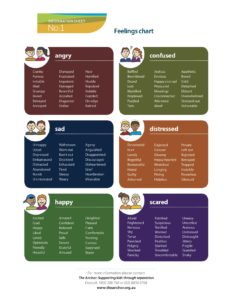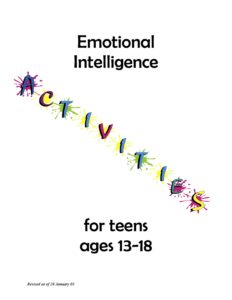Play Therapy at Home: Day 13 Teenagers and Feelings
I realize it’s been a long time since I’ve written. Life happens and you have to make room for it. In the time that has gone by, though I have some new things to address. I’ve done several basic play therapy ideas for small children and I thought I would address some teenager issues. I have been working with parents of teenagers a lot lately. I fully admit that I am not one yet, but I hope that won’t discourage you- in fact I love the feedback from those who are “in the trenches”. I can give you some ideas and insight from what I like to do in my office with the teenagers I am seeing, though.
Social media is KILLING our youth. I would have to address this in multiple blogs, but for today I want to address the expression of feelings. I know that sounds sappy, for those who aren’t in the counseling world, but expressing what’s going on inside is crucial to the art of communicating, your self-esteem, being understood by others, and relating to others. Social media, texting, technology are deteriorating basic communication abilities. When you are constantly able to edit your response, you never have to think on your feet. You can text, erase an email before sending it, or wait to respond. Teenagers are having an emotional response inside and are limited on their ability to express it out loud. Some of this is developmental as they still think like a child, yet want to be treated like a grown-up. Expecting them to automatically know what they feel and express it, let alone know what to do with it is too high of an expectation. What teenagers need is help identifying their feelings, adding more words, and then practice communicating it.

 An intern that works with me came up with a fun idea for one of the teenagers we were seeing who had this exact goal. When she first came in, like many of the teenagers I meet, their blanket feeling words are “happy, frustrated, angry, and upset”. But most of the time, their answer is “I don’t know”. So we first introduced the feeling chart. I found a good one here that’s included in the PDF that has some extra information within.
An intern that works with me came up with a fun idea for one of the teenagers we were seeing who had this exact goal. When she first came in, like many of the teenagers I meet, their blanket feeling words are “happy, frustrated, angry, and upset”. But most of the time, their answer is “I don’t know”. So we first introduced the feeling chart. I found a good one here that’s included in the PDF that has some extra information within.
Because young teenagers enjoy games still, we used skittles and M&M’s as bait 🙂
Actually, we (using the feelings connected to colors that I have mentioned previously), had the teenager assign feelings to each color. Of course, we expected the feelings she chose to be her usual generic ones mentioned above. Then we took turns picking up a piece of candy (with our eyes closed to prevent avoidance of certain colors) and told about a time when we felt that emotion. From a therapist perspective, it is usually ethical to avoid too much disclosure, but when working with teenagers, it helps model the normalcy of experience as well as establish a safe relationship. I would definitely encourage parents to tell their story, yet try to not date themselves. Choose stories that they can relate to.
To take it to another level, I asked the teenager to try using three extra “feeling words” to describe her feelings during the story. “Upset” can be broken down to embarrassed, overwhelmed, and discouraged. Then, once they are finished with the story, I asked, using those words, how would she communicate her feelings to [that] person.
So, for example… I’m completely making this up…
“Mom, when you yell at me, it makes me feel overwhelmed, scared, and discouraged.” Which is MUCH better than “My mom makes me upset.”
Of course the next level, which I would recommend you try later once your teenager feels confident in identifying their feelings better, is trying to think out how they would ask their Mom to try something different. This not only takes great courage, but a humble parent who is willing to see their own opportunities for change. Many of the serious issues I see with teenagers are not just a problem with the child. Rarely is it only them, it is usually a family dynamic problem. I am often forced to carefully address the parents and talk about what changes they need to make in order to see their teenager’s behavior change.
I hope to write much more on this in future blogs, but for now let me encourage you with this. Your teenager still has a child brain that cannot think through the future. They cannot see or think out consequences or often solutions for what they feel. That is hard to keep in mind when they look on the outside like an adult. The best advice I can give is this…
Your teenager wants you to treat them like an adult for the things they know how to do and have proven/earned it. They desperately need your help in teaching them on the things they do not know how to do and enjoy being taught when done in fun ways that involve quality time with you. Deep down inside, they need to be loved like a child, especially in private. This doesn’t necessarily mean physical affection- but more tending to their heart by acceptance, affirmation, loving them through their mistakes, and caring about what they care about. Don’t let the “front” on the outside, convince you otherwise. They just don’t know how to ask for it without negating that they also want to have some adult responsibility. As confused as you may feel, so are they- so just love them anyways!
 Here is another resource that I found that I hope to use in a future session. This would be great for group settings if you are involved in a youth group. Speaking of that- I will try to write a future blog on the Power of Peers, too!
Here is another resource that I found that I hope to use in a future session. This would be great for group settings if you are involved in a youth group. Speaking of that- I will try to write a future blog on the Power of Peers, too!
As always, comments are great! 
